For many owners of private houses and summer cottages, the concept of alternative energy is associated with expensive solar panels, wind turbines or heat pumps. No one even realizes that in just a few hours, for mere pennies, you can build a solar collector from plastic bottles to supply yourself with hot water throughout the warm season.
We will tell you how to make an effective sanitary water treatment system from waste materials. In our proposed article, you will find a detailed description of the structures and methods of manufacturing systems, the operation of which has been tested in practice. Taking into account our recommendations, you can easily assemble a device that is useful in the household.
The content of the article:
- Specific application of solar collectors
- Design features and principle of operation
-
Assembling the unit from scrap materials
- Hot water storage option
- Hot water circulation method
- Features of gluing PVC pipes
- Solar collector manufacturing procedure
- Features of placement and connection
- Conclusions and useful video on the topic
Specific application of solar collectors
The main difference between a solar collector and various types of heat generating solar systems consists in the cyclical nature of the work. In other words, in the absence of the sun, there will be no heat energy.
Obviously, in the dark, the performance of an autonomous hot water supply with a solar collector is reduced to zero. The heat production of the solar collector is determined by the length of the daylight hours, which depends on the latitude and the time of the year.
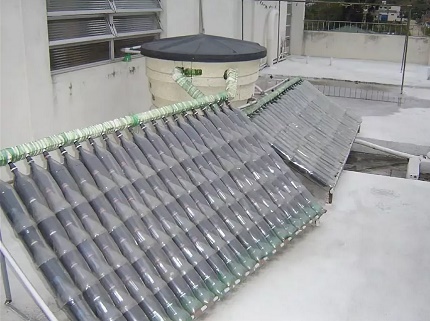
A homemade solar collector will solve not only the issue of supplying hot water to a house that is not connected to central networks, but also heating problems
The climatic features of the area also have a significant impact on the performance level of the solar collector. If the area is characterized by frequent fogs or the sun is often hidden behind clouds, then the performance of the solar collector is significantly reduced.
However, in this case too solar collector for heating and / or water heating remains effective due to the ability to capture even scattered rays.
Design features and principle of operation
The main element of the standard solar collector is an adsorber in the form of a copper plate with a tube. The plate heats up quickly under the influence of sunlight, transferring heat to the tube and the liquid in it. Thanks to free or forced circulation, the resulting heat is further transported throughout the system.
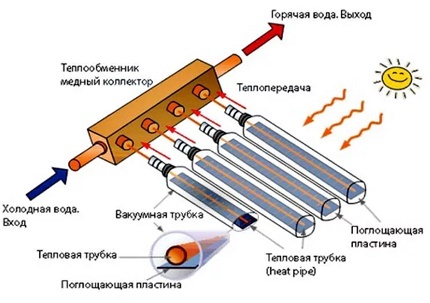
Under the influence of sunlight, the copper plate heats up, from which heat is transferred to the coolant in the tube
To increase the efficiency of the adsorber, it should be endowed with the necessary physical properties. First of all, it is necessary to increase the absorption capacity of the adsorber and minimize the reflection of sunlight. The simplest solution would be to apply black paint to the adsorber.
To increase the efficiency of the adsorber, it must be covered with transparent glass. Regular glass reflects some of the sun's rays.
It is best to use special glass with a low iron content or use an anti-reflective coating. To avoid contamination of the glass, the housing of the solar collector must be sealed.
Despite the many ways to improve the operation and increase the performance of the solar collector, due to the imperfection of the design, this indicator is far from ideal. Taking into account the principle of operation of the solar collector and methods of increasing its efficiency, we will try to create a primitive and inexpensive model from scrap materials.
Assembling the unit from scrap materials
In addition to being cheap and easy to assemble, the plastic bottle version differs from standard solar devices in that flat solar collectors do not work well in the morning and evening hours.
The convex shape of the bottles ensures almost vertical penetration of rays even during sunset and dawn, thereby ensuring the efficiency of the device, both in the morning and in the evening watch.
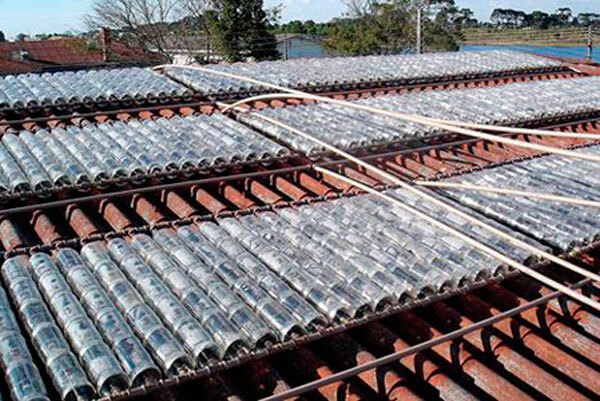
Due to the convex shape of plastic bottles, the device, even when horizontal, is able to catch the rays of the rising and setting sun
There are several distinctive ways to build a perfectly working hot water system from plastic bottles:
- The solar collector acts as a storage tank in which the water is heated and then drained;
- The solar collector is connected to the storage tank to ensure water heating and natural circulation;
- The plastic bottle collector acts as a water reservoir;
- Plastic bottles act as sealed containers to keep warm.
Also, solar collectors can differ in their design features. First of all, this is due to both the way the bottles are fastened and the way they are located.
Hot water storage option
To make a solar collector you will need polypropylene pipe with a diameter of 50 mm, to which plastic bottles will be connected, the number of which is determined by the diameter of the pipe. For the template, 15 plastic bottles were taken, so the working capacity of the solar collector was 30 liters.
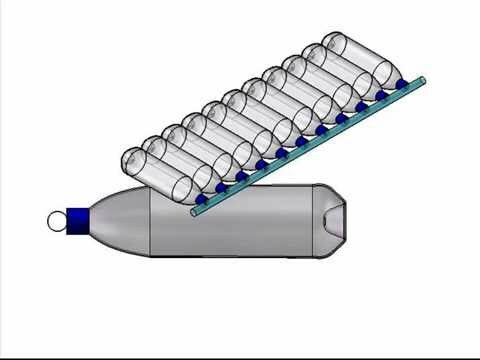
The joints between the bottles and the propylene pipe are coated with silicone sealant, preventing water leakage
To connect the bottles into a single system, holes must be drilled in a propylene pipe intended for hot water supply. The ideal solution was to use a 26 mm wood drill.
With such dimensions, the maximum tightness of the connection is ensured, and the bottle is forcefully screwed into the hole along its thread. To ensure maximum sealing of the connection, the joints can be coated with silicone sealant, but it is better to use hot melt glue.
To achieve the effect of interconnecting vessels, holes with a diameter of about 2 mm must be made in the upper part of each bottle.
After connecting the bottles, a fitting is cut in on one side of the pipe, which will later be connected to the water supply system for supplying water. On the other hand, a tap should be cut through which the heated water will be drained into the storage tank.
However, under the weight of the filled water, such a device for household use solar energy may lose its integrity. Therefore, it will be advisable to arrange a box. To make it, you need a board 150 mm wide.
To increase the efficiency of the solar collector, 50 mm thick foam or expanded polystyrene can be placed on the bottom of the box and covered with foil.
After installing the solar collector in place of its further use, the plastic bottles must be painted black in order to more efficiently absorb the sun's rays.
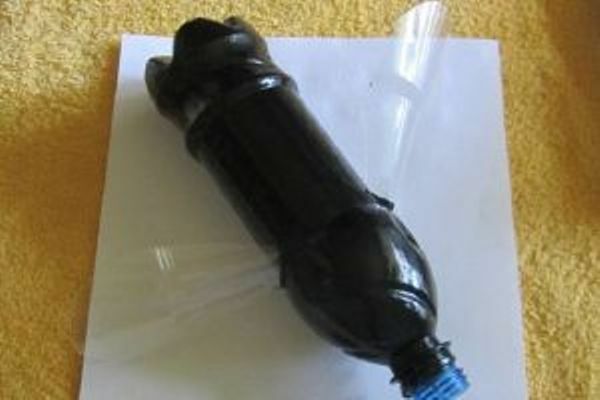
When dyed black, the absorption capacity of the plastic increases and the efficiency of heating water increases.
It is better to use matte paint and apply by spray from an aerosol can. It remains to cover the box with glass, thereby increasing its tightness and connect it to the cold water supply system and the drainage system of warm water prepared for use into the storage tank.
It is known from practical experience that plastic does not tolerate high temperatures, which lead to its deformation. On bright sunny days, the temperature of the heated water can exceed 65 degrees, which will lead to deformation of the plastic.
In this regard, it is better to refuse additional sealing of the box with glass at all, or use it exclusively in cloudy weather.
Hot water circulation method
The solar collector system is similar to the first option, but has a number of structural differences.
To create a manifold, you will need the following tools and materials:
- PVC pipe with a diameter of 20 mm with corners and tees;
- Roller pipe cutter;
- Chamfering cutters;
- Primer (cleaning agent);
- Plastic bottles;
- Tetrapaki milk or juice;
- Stationery knife;
- Cardboard;
- Heat-resistant matt black paint;
- Storage tank.
For installation, we need a PVC pipe with a diameter of 20 mm. The horizontal part of the pipe should be cut into sections, into which angles and tees will be joined by cold welding. The bottom of the solar collector will look exactly the same. The end result is a closed system, but let's talk about everything in order.
Features of gluing PVC pipes
To obtain a high-quality cut, it is better to use pipe cutterequipped with casters. After cutting, the inside of the pipe must be chamfered using special chamfering tools.
After measuring the depth of tees and angles, you need to set a mark on the end of the pipe to be connected and treat the ends of the pipes and fittings with a primer (cleaning agent).
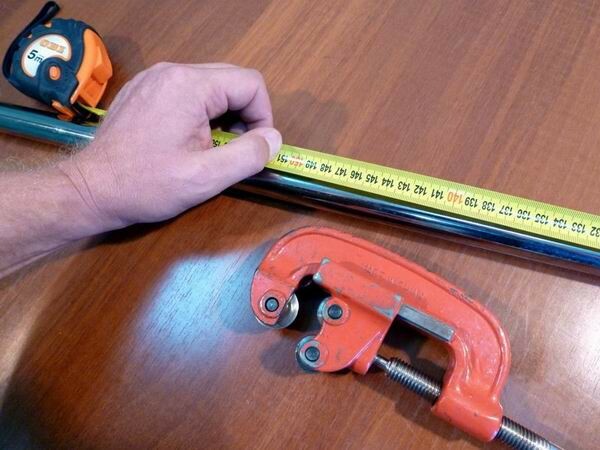
Thanks to the smooth movement of the cutting part, the roller pipe cutter avoids cross-section deformations and the formation of burrs along the edge when cutting
The next step is to apply and distribute the adhesive to the outside of the pipe and the inside of the fitting. The adhesive must be applied with a brush, and its size must be smaller than the diameter of the pipes. It remains to insert the pipe into the prepared tee or corner and turn it a quarter of a turn to evenly distribute the glue.
It should be borne in mind that the work on gluing one corner or tee should be completed no longer than 30 seconds. After fixing, it is necessary to remove the remaining glue.
Solar collector manufacturing procedure
After the top tube has been prepared and the risers are connected to it, the plastic bottles can be prepared. The presented model of the solar collector has 4 vertical pipes 105 cm long, 5 plastic bottles can be placed on this length of the pipe. That is, 20 plastic identical bottles are required to assemble the collector.
The bottom must be removed from each bottle. To do this, a simple template should be made from a 30 cm long piece of cardboard rolled into a tube. Using a template and a clerical knife, remove the bottom of the bottles. After preparing the bottles, you can start making an absorber that will absorb solar energy.
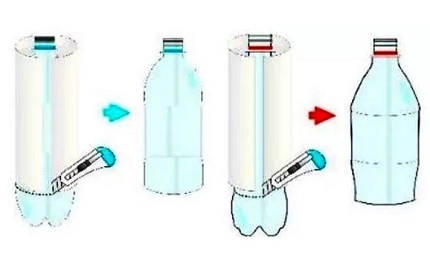
Using a simple cardboard template allows you to quickly cut and get bottles of the same size
We use used juice or milk tetrapacks as an absorber. They must be cut, washed thoroughly and dried. To improve their absorbency, a matt black paint should be applied. The easiest way to do this is to use spray paint from a spray can.
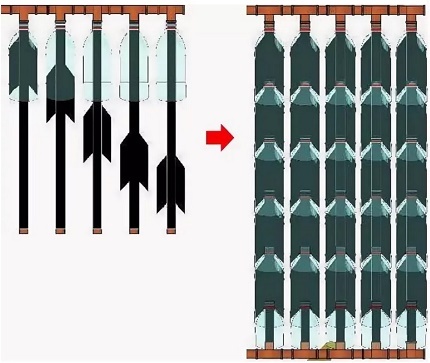
Sequential stringing of plastic bottles makes it easy to place folded tetrapacks in them
After preparing the bottles and tetrapacks, you can start assembling the solar device. First, you need to string a plastic bottle with the neck forward on a vertical tube and insert a tetrapak into it. In a similar way, all the bottles are strung on vertical tubes, which then must be connected to the tees and corners of the lower pipe, similar to the upper one.
To stiffen the manufactured solar collector, it is necessary to make a support for it.
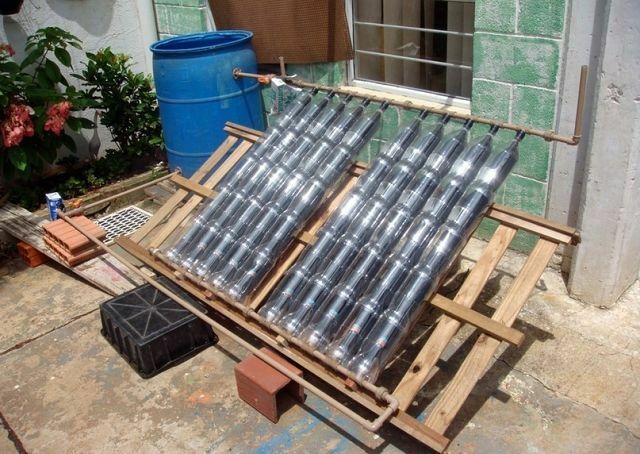
A common wooden shield gives rigidity to the structure and makes it easy to move the solar collector to the place of its operation
It is possible, as in the first case, to place the collector in a wooden box, but there is no need to insulate it. Since each of the plastic bottles is a kind of small insulated tank, which, warming up from the inside, transfers heat to the water circulating through the tubes.
Features of placement and connection
For the maximum possible absorption of sunlight, the collector should be oriented towards the south. A small tilt angle of 10-15 degrees is enough for the collector to work effectively in almost any position of the sun.
The lower part of the pipe must be connected to the lower part of the storage tank, and the upper one approximately to its central part. Cold water from the polymer container will flow through the lower pipe to the collector, where it will be heated and rise through the upper pipe to the tank.
Thus, the natural circulation of water will be carried out through a home-made system. To ensure a high rate of water circulation, the tank should be located just above the solar collector at a distance of at least 0.3 m from it.
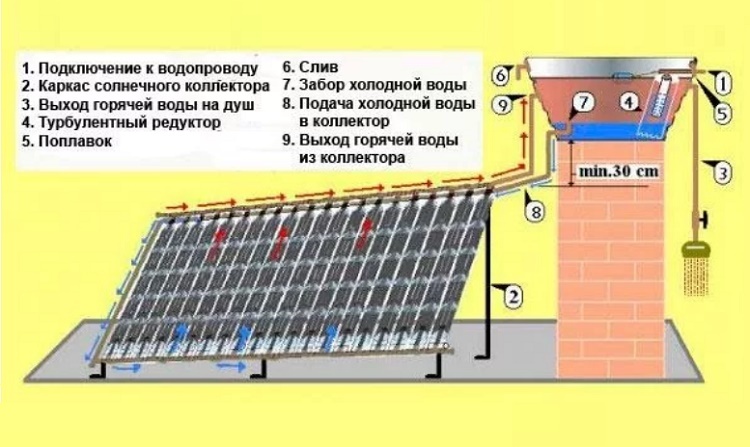
With the correct connection of the solar collector to the storage tank, natural water circulation is ensured
It should be noted that when cold water enters the tank from the water supply system, it is actively mixed, which reduces the efficiency of the collector. This can be avoided by equipping the tank inlet with a turbulent reducer, which is a plugged tube with multiple holes.
Water flows smoothly through the reducer, which allows cold water to remain in the lower layers, from where it is drawn into the solar collector.
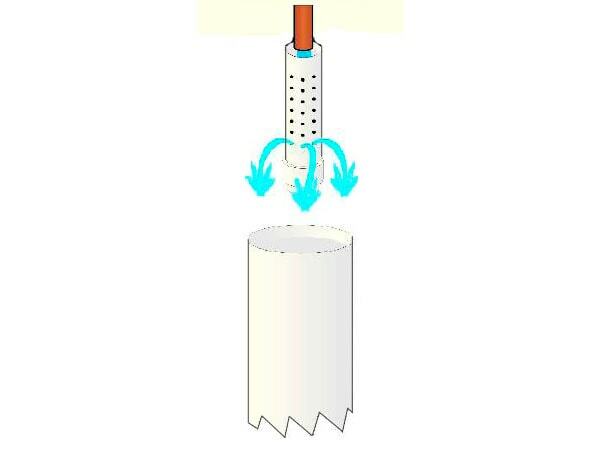
The use of a turbulent reducer helps to avoid mixing cold and warm water in the storage tank
Obviously, the solar collector provides water heating only during the daytime in sunny weather. Therefore, it is important to store hot water for use during the day and evening. For this, it is necessary to insulate the storage tank.
Conclusions and useful video on the topic
Video 1. This is how the first solar systems from plastic bottles appeared:
Video 2. Almost free device for heating water in action:
A solar collector made from plastic beverage containers is a cheap solution for producing hot water. However, in case of prolonged bad weather, especially in spring and autumn, it is advisable to install a heating element in the storage tank. In this case, the solar collector will become part of a complete system, which, under favorable conditions, will save money.
Tell us about your experience in building a homemade solar system from plastic bottles. It is possible that in your arsenal there are information and design options that may be useful to site visitors. Please write your comments in the block form below, ask questions, share photos and useful information.


